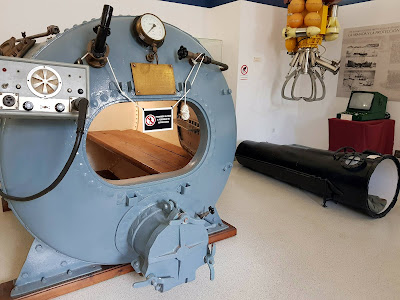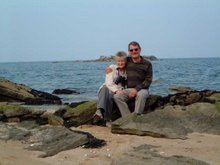Cartagena was Hannibal’s headquarters in Spain, named after his capital Carthage in north Africa. We drove the 10 miles or so to the city, as we usually do when we stay in this area.
Today, it’s a first time visit to the naval museum on the
quayside. By chance, the museum’s first exhibits carry on with the frogman
theme from the previous blog. However impractical climbing a mountain in scuba
kit would seem, with this gear on, as shown in the next photo, it would clearly
be impossible. However, he looks rather cute, like those free plastic toys you
used to get in cornflakes packets.
Now comes the practical world of de-compression chambers. These reverse the potentially lethal effect of “the bends”: nitrogen bubbles in the blood caused by a diver surfacing too quickly. The chamber reapplies deep water pressure and slowly reduces it as if the diver had come up more slowly. The photo shows two early examples, the first one of which seems self explanatory with a bench inside for the divers to sit while they de-pressurise. However, with the second one, the ailing diver is now forced into this narrow, tapering tube and then a lid affixed so that the pressure treatment can be applied. But what if he’s chubby, or claustrophobic? The upside is, if the treatment didn’t work, it’s a ready-made burial kit.
Still in the underwater section, a happier tableau – the
regimental band’s music and instruments. It does begs practical questions like,
how do you play, say, a clarinet under water or stop fish swimming up the end
and spoiling the tune? However, maybe you could manage drumming in the
cornflakes packet divers suit shown previously.
Coming up to the water surface we arrive at the early
torpedoes. Most striking is this beautifully shiny copper casing that you’d
definitely need a BA (Brasso) for these day.
In the next section are lots of model ships, beautifully
made, although it must be said that the first vessel’s sails seem to have be
made from the model maker’s wife’s underwear.
So this is what a sailor in Christopher Columbus’ time would
be wearing. It also serves as a Morris dancing outfit.
On the way out we pass an amazingly artistic column of rope
work, all rope, apart from the wooden support column.
The museum exit decants us onto the harbour front where the
cruise ships dock. These are monsters, today’s arrival is the Aida Cosmo in the
photo which carries up to 5,000 passengers and 1,500 crew.
No sooner are we in the city centre, two minutes walk from
the harbour, when we hear marching drum-beats: another parade, this time it’s a
legion of Roman soldiers. This is most appropriate as Cartagena was an
important Roman city with a large theatre. The legion marches around the city in
immaculate Roman attire (or so we onlookers believe) for most of the few hours that
we are here,
The centre is fully pedestrianised
and very elegant, with shops and café-lined squares charging just normal prices.
Here’s one such square.
We leave the centre heading for the harbour again where
we’ve parked in the underground carpark. Glancing back towards the city, the
traffic-free, tiled entrance maintains its classy, stylish image.











